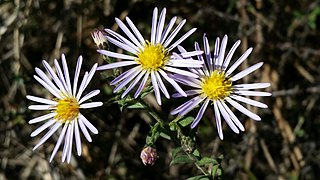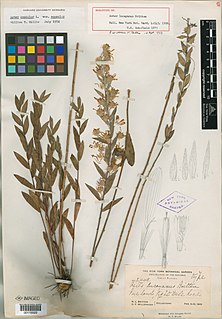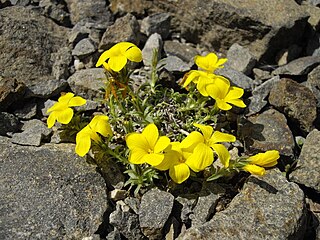
Nepeta is a genus of flowering plants in the family Lamiaceae. The genus name is reportedly in reference to Nepete, an ancient Etruscan city. There are about 250 species.

Aethionema is a genus of flowering plants within the family Brassicaceae. They are known as stonecresses. Stonecresses originate from sunny limestone mountainsides in Europe and West Asia, especially Turkey.
Aegilops kotschyi is a member of the grass family, Poaceae, native to the Levant.

Biarum is a genus of flowering plants in the family Araceae. It is composed of plants that are native to the Middle East, southern Europe, and North Africa. Biarum are often found growing in rock crevices and graveled soil composed largely of limestone.

Solidago gigantea is a North American plant species in the sunflower family. Its common names include tall goldenrod and giant goldenrod, among others.

Lumnitzera is an Indo-West Pacific mangrove genus in the family Combretaceae. An English common name is black mangrove. Lumnitzera, named after the German botanist, Stephan Lumnitzer (1750-1806), occurs in mangroves from East Africa to the Western Pacific, and northern Australia.

Colchicum kotschyi is a species of flowering plant in the Colchicaceae family. It is native to Iran, Iraq and Turkey. It blooms relatively early for an autumn flowering colchicum, as early as August. The flowers open to a pink-purple colour, but white flowered specimens are common in the wild. The plant reaches up to 2 m (6") tall and grows well in sunny, warm locations.

Symphyotrichum lanceolatum is a species of flowering plant in the family Asteraceae native to North America. Common names include lance-leaved aster, panicled aster, and white panicled aster. It is a perennial, herbaceous plant that may reach 1.5 meters tall or more, sometimes approaching 2 meters. It has a stout rhizome and can spread to form a clonal colony. The species is currently divided into five varieties which have minor differences in appearance and vary in chromosome counts as well as distribution, with some overlap.
Sedum lampusae is a species of flowering plant in the family Crassulaceae. It is an erect herb to 50 cm, dying after one flowering. Basal leaves flat, glaucous, fleshy, spoon-shaped, 4–10 cm long, forming neat rosette which usually shrivels before the flowers open; steam leaves progressively smaller; inflorescence a long cylindrical or pyramidal spray, flowers numerous, crowded, brownish green, calyx-lobes and petals both 5, the latter narrow, pointed, 4 mm long, with a dark central vein. Stamens 10, follicles usually 5, erect, 5 mm long. Flowers from June to August. Common name is Lapta Damkoruğu.
Sedum microstachyum is a species of flowering plant in the family Crassulaceae. It is referred to by the common name small-spiked stonecrop. It is an erect, succulent, monocarpic herb, with an unbranched stem up to 40 cm high. Leaves succulent, simple, entire, glandular, hairy, reddish in sunny positions, sessile, the basal crowded in rosettes, spathulate-linear 3-7 x 0.5-1.5 cm, the higher smaller, spirally arranged. Flowers actinomorphic, small, reddish or greenish, in a cylindrical panicle, Flowers from June to September. Fruit a many-seeded follicle.
Quercus vulcanica is a species of flowering plant in the Fagaceae family. It is referred to by the common name Kasnak oak, and is a rare species of tree native to Lebanon, Syria, and Turkey.
Prunus kotschyi is a plant first described by Pierre Edmond Boissier and Rudolph Friedrich Hohenacker, and received its current name from a revision by Robert Desmond Meikle. No subspecies are known. It is native to Iraq.

Hypericum sechmenii, commonly called seçmen kantaronu in Turkish which means Seçmen's St. John's wort in English, is a rare species of flowering plant of the St. John's wort family (Hypericaceae) that is found only in the Eskişehir Province of central Turkey. It was described by Turkish botanists Atila Ocak and Onur Koyuncu who named the species in honor of Özcan Seçmen, a fellow Turkish botanist. Found in the crevices of exposed limestone, it is a perennial herb which grows in clusters of stems 3–6 centimetres tall and blooms June to July with bright yellow five-petalled flowers. Formally described in 2009, the species was first collected in 2006 and has since been found in only two localities with an estimated population of less than 250.

Symphyotrichum ciliatus is a species of flowering plant in the family Asteraceae native to North America and eastern Eurasia. Commonly known as rayless annual aster or rayless alkali aster, it is an annual, herbaceous plant that may reach over 70 centimeters high. As composite flowers, each flower head has many tiny florets put together into what appear as one, as do all plants in the family Asteraceae.

Symphyotrichum fontinale is a species of flowering plant in the family Asteraceae endemic to Florida. Commonly known as Florida water aster and Florida water American-aster, it is a perennial, herbaceous plant that may reach 30–90 centimeters high. As composite flowers, each flower head has many tiny florets put together into what appear as one, as do all plants in the family Asteraceae.

Symphyotrichum lucayanum is a species of flowering plant of the aster family (Asteraceae) endemic to the North American island of Grand Bahama.
Asyneuma compactum is a species of flowering plant in the Campanulaceae family which is endemic to Turkey.

Linum cariense is a species of flowering plant in the family Linaceae which is endemic to Turkey.
Hypericum thymopsis is a species of flowering plant in the family Hypericaceae which is endemic to Turkey.
Achyranthemum, commonly called chaff flowers, is a genus of flowering plant in the family Asteraceae which is native to South Africa. The genus was first described by Nicola Bergh in 2019 in the South African Journal of Botany, and it was segregated from the genus Syncarpha due to its representation of a separate lineage.











